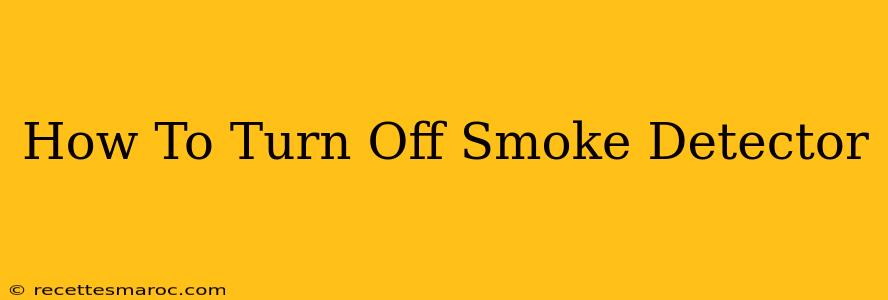A constantly beeping smoke detector can be incredibly frustrating. This guide will walk you through various scenarios and methods for silencing that annoying alarm, while emphasizing safety and preventing future issues. We'll cover everything from temporary silencing to identifying and fixing the underlying problem.
Understanding Why Your Smoke Detector is Beeping
Before you attempt to turn off your smoke detector, it's crucial to understand why it's beeping. A beeping sound usually indicates one of the following:
- Low Battery: This is the most common reason. The detector needs new batteries.
- End-of-Life: Smoke detectors have a limited lifespan (usually around 10 years). A beeping sound might signal it's time for a replacement.
- Dust or Debris: Accumulated dust can interfere with the sensor, triggering false alarms.
- Actual Fire or Smoke: This is the most serious reason. Never ignore a smoke detector that's beeping in the presence of smoke or fire; evacuate immediately.
- Malfunctioning Sensor: Occasionally, the sensor itself might malfunction, leading to false alarms.
How to Temporarily Silence a Beeping Smoke Detector
If the beeping is due to a low battery or dust, you can usually silence it temporarily. However, this doesn't address the underlying problem and should be considered a temporary fix only.
For Low Battery:
- Locate the smoke detector's battery compartment (usually on the back or side).
- Open the compartment and replace the batteries with fresh ones of the correct type and voltage. Consult your detector's manual if unsure.
- The beeping should stop once the new batteries are installed. If it persists, proceed to the troubleshooting section.
For Dust or Debris:
- Carefully use a vacuum cleaner with a brush attachment to gently remove dust and debris from the smoke detector's sensor. Avoid using excessive force to prevent damage.
- Check for any obstructions around the sensor.
- If the beeping continues after cleaning, proceed to the troubleshooting section.
Troubleshooting Persistent Beeping
If replacing batteries and cleaning the sensor doesn't resolve the beeping, you may need to take more significant steps:
- Check the Manual: Refer to your smoke detector's manual for troubleshooting tips specific to your model.
- Test the Detector: Many smoke detectors have a test button. Press it to see if the alarm sounds. If it doesn't sound, the detector may be faulty and need replacing.
- Check for Wiring Issues (Hardwired Detectors): If your detector is hardwired, there might be a problem with the wiring. You'll likely need a qualified electrician to diagnose and fix this.
- Replace the Smoke Detector: If you've tried everything else, it's time to replace the smoke detector. Smoke detectors are relatively inexpensive and replacing one is a much better solution than enduring false alarms.
Choosing and Installing a New Smoke Detector
When purchasing a replacement smoke detector, consider the following:
- Type: Choose a smoke detector appropriate for your home's type of construction and potential fire hazards (ionization or photoelectric).
- Interconnectivity: Consider smoke detectors that are interconnected, so if one goes off, they all go off. This helps alert everyone in the house quickly.
- Battery Life: Look for long-lasting batteries to minimize interruptions.
- Installation: Follow the manufacturer's instructions carefully when installing your new smoke detector. Ensure they're placed in the correct locations according to building codes.
Important Safety Note: Always prioritize safety. If you are unsure about any aspect of smoke detector maintenance or replacement, contact a qualified electrician or fire safety professional. Your safety and the safety of your family are paramount.

